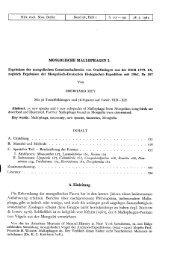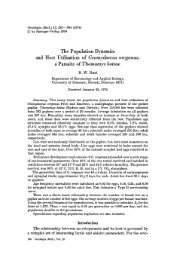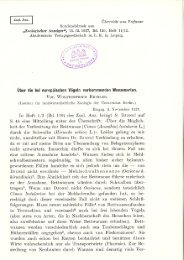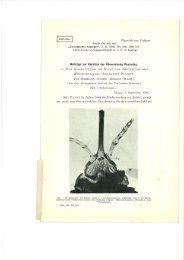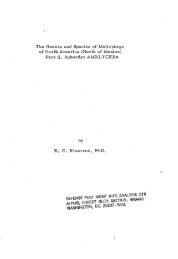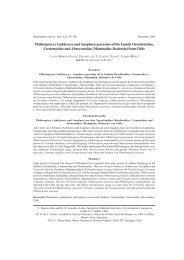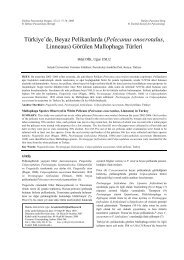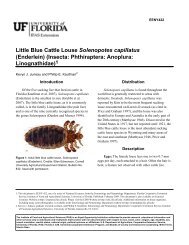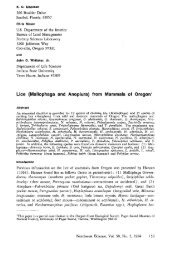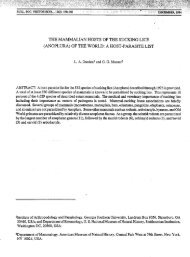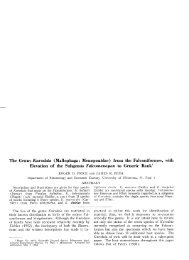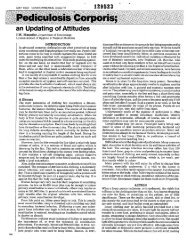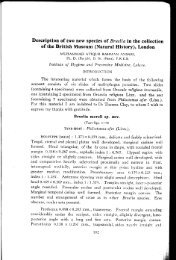The Geographical and Ecological Distribution of Arboreal Psocoptera
The Geographical and Ecological Distribution of Arboreal Psocoptera
The Geographical and Ecological Distribution of Arboreal Psocoptera
Create successful ePaper yourself
Turn your PDF publications into a flip-book with our unique Google optimized e-Paper software.
Annu. Rev. Entomol. 1985.30:175-196. Downloaded from arjournals.annualreviews.org<br />
by Mr. Bas van Berkum on 10/10/07. For personal use only.<br />
Annual Reviews<br />
www.annualreviews.org/aronline<br />
186 THORNTON<br />
Although New Guinea has been inadequately surveyed, there are indications<br />
that it has been an important link between the greater Sunda isl<strong>and</strong>s <strong>and</strong> the<br />
isl<strong>and</strong>s <strong>of</strong> the Outer Melanesian Arc in the case <strong>of</strong> the Pseudocaeciliidae,<br />
Peripsocidae, Ectopsocidae, a subgroup <strong>of</strong> the Myopsocidae, <strong>and</strong> Calopsocus<br />
(Calopsocidae) <strong>and</strong> Epipsocopsis (Epipsocidae) (77, 89). Considerable evolution<br />
has occurred in New Guinea itself with the production <strong>of</strong> seven endemic<br />
genera. <strong>The</strong>re is also speculation that differentiation <strong>of</strong> philotarsid genera may<br />
have occurred in the area, where several unusual forms are found (77, 86).<br />
Relatively recent contributions from the New Guinea area to the faunas <strong>of</strong><br />
northeast Australia in the above families <strong>and</strong> the Stenopsocidae, <strong>and</strong> to the<br />
fauna <strong>of</strong> east Australia in the Myopsocidae, Stenopsocidae, <strong>and</strong> Psilopsocidae<br />
are indicated.<br />
Biogeographical studies on the archipelagos <strong>of</strong> the southwestern Pacific are<br />
still incomplete, although specialist collections have been made as far as<br />
Tonga. It is already clear that no single hypothesis can explain existing<br />
patterns, which vary from family to family <strong>and</strong> within some families. Within<br />
the Philotarsidae, for example, vicaxiance <strong>and</strong> dispersal explanations have been<br />
<strong>of</strong>fered for different sections <strong>of</strong> the family (81,83). <strong>The</strong> subfamily Zel<strong>and</strong>opsocinae,<br />
strictly confined to the Inner Melanesian Arc, has a species swarm on<br />
New Caledonia, <strong>and</strong> links between New Zeal<strong>and</strong> <strong>and</strong> New Guinea. are recognizable.<br />
In contrast, the Outer Arc has been colonized by the sister subfamily<br />
Aaroniellinae, probably by dispersal. <strong>The</strong> Calopsocidae <strong>and</strong> Epipsocidae also<br />
occur on the Outer Arc, <strong>and</strong> in the Pseudocaeciliidae, Psocidae, Lepidopsocidae,<br />
<strong>and</strong> Myopsocidae there has been radiation in Fiji (82). <strong>The</strong> Fijian fauna (81<br />
species) is 60% endemic, <strong>and</strong> in general an Oriental-Melanesian origin is<br />
indicated. Tonga’s fauna is an attenuation <strong>of</strong> that <strong>of</strong> Fiji.<br />
In the Psocidae also, a variety <strong>of</strong> patterns can be seen. Amphigerontiines<br />
extend only as far as Norfolk Isl<strong>and</strong> <strong>and</strong> New Zeal<strong>and</strong>, <strong>and</strong> the genus Psococerastis<br />
does not appear to have penetrated either the Inner or Outer Melanesian<br />
Arcs. Of the Psocinae, Ptycta, the only genus <strong>of</strong> the family in Micronesia<br />
(six species), occurs in Australia, has three species in the Bismarcks, <strong>and</strong><br />
weakly represented along the Outer Melanesian Arc as far as Tonga, but,<br />
remarkably, has not yet been found in New Guinea. Its range in this region<br />
appears to complement that <strong>of</strong> the related Copostigma, a genus that is unknown<br />
from Australia, has five species in New Guinea, is absent from the Bismarcks<br />
<strong>and</strong> Solomons, but has four species in the New Hebrides <strong>and</strong> seven in Fiji.<br />
Clematoscenea, like Copostigtna, is absent from Australia <strong>and</strong> well represented<br />
in New Guinea (eight species), but through the Melanesian Arcs their<br />
ranges are mutually exclusive.<br />
Ninety species are known from Micronesia, 54 <strong>of</strong> which occur in the<br />
southern Mafianas. Endemism is highest (over 30%) on Truk, the southern<br />
Marianas, <strong>and</strong> Palaus; Yap <strong>and</strong> Kusaie, with faunas <strong>of</strong> a size similar to that <strong>of</strong>



